Legacies of Lead in Charm City’s Soil: Lessons from the Baltimore Ecosystem Study
Abstract
:1. Introduction
2. Methods
3. Lessons Learned
3.1. Lesson 1—Soil Lead Exceeds Regulatory Limits
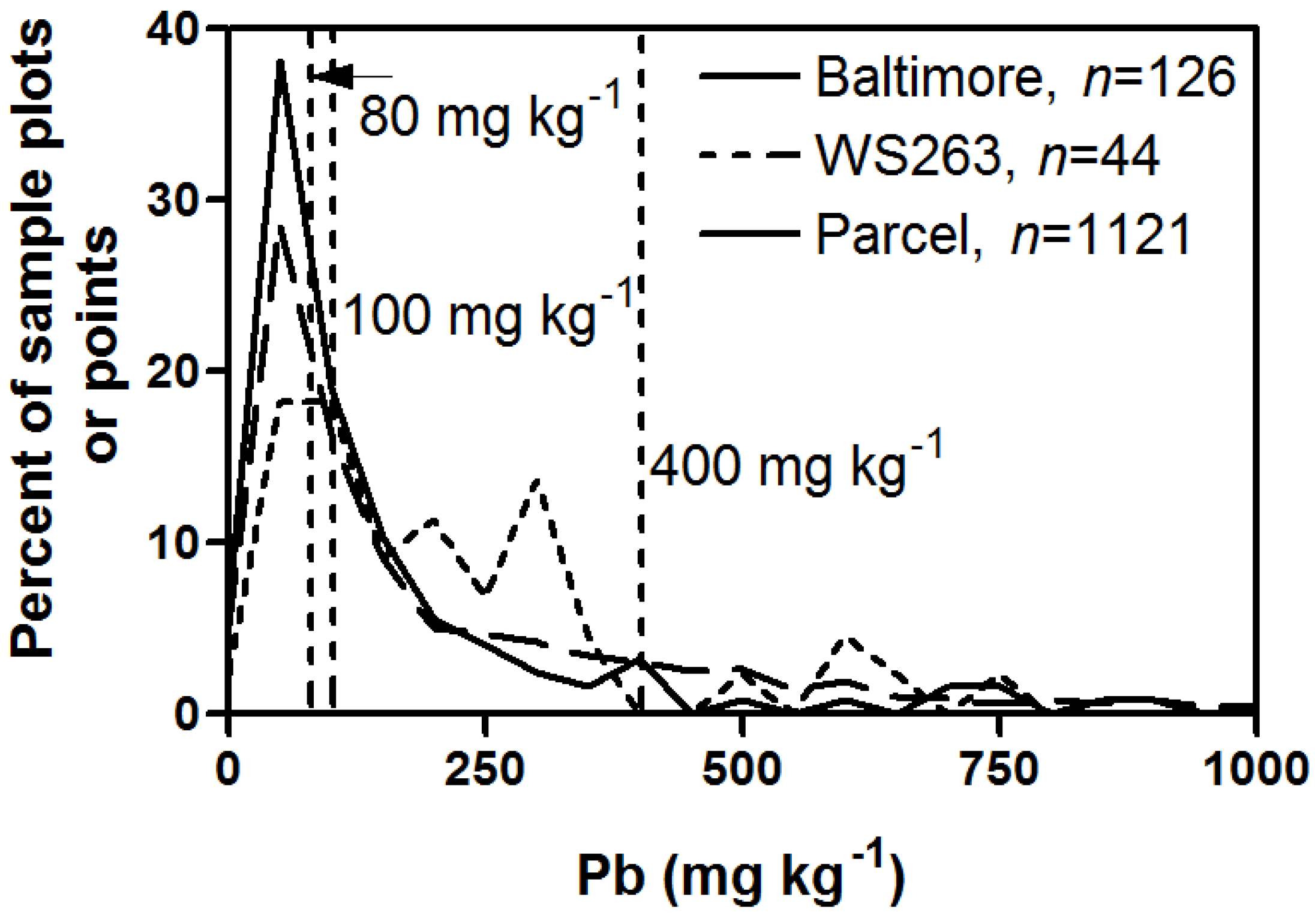
| Guideline Value (mg·kg−1) | 80 | 100 | 400 | 1200 | Min. Pb (ppm) | Max. Pb (ppm) | Mean Pb (ppm) | Standard Deviation | n |
|---|---|---|---|---|---|---|---|---|---|
| Parcel | 63% | 56% | 22% | 6% | 7 | 9151 | 363 | 794 | 1121 |
| Watershed 263 | 77% | 73% | 16% | 2% | 22 | 2495 | 292 | 405 | 43 |
| Baltimore City | 55% | 43% | 10% | 2% | 4 | 5652 | 229 | 572 | 126 |
3.2. Lesson 2—The Variability of Soil Lead Is High

3.3. Lesson 3—Patterns Exist
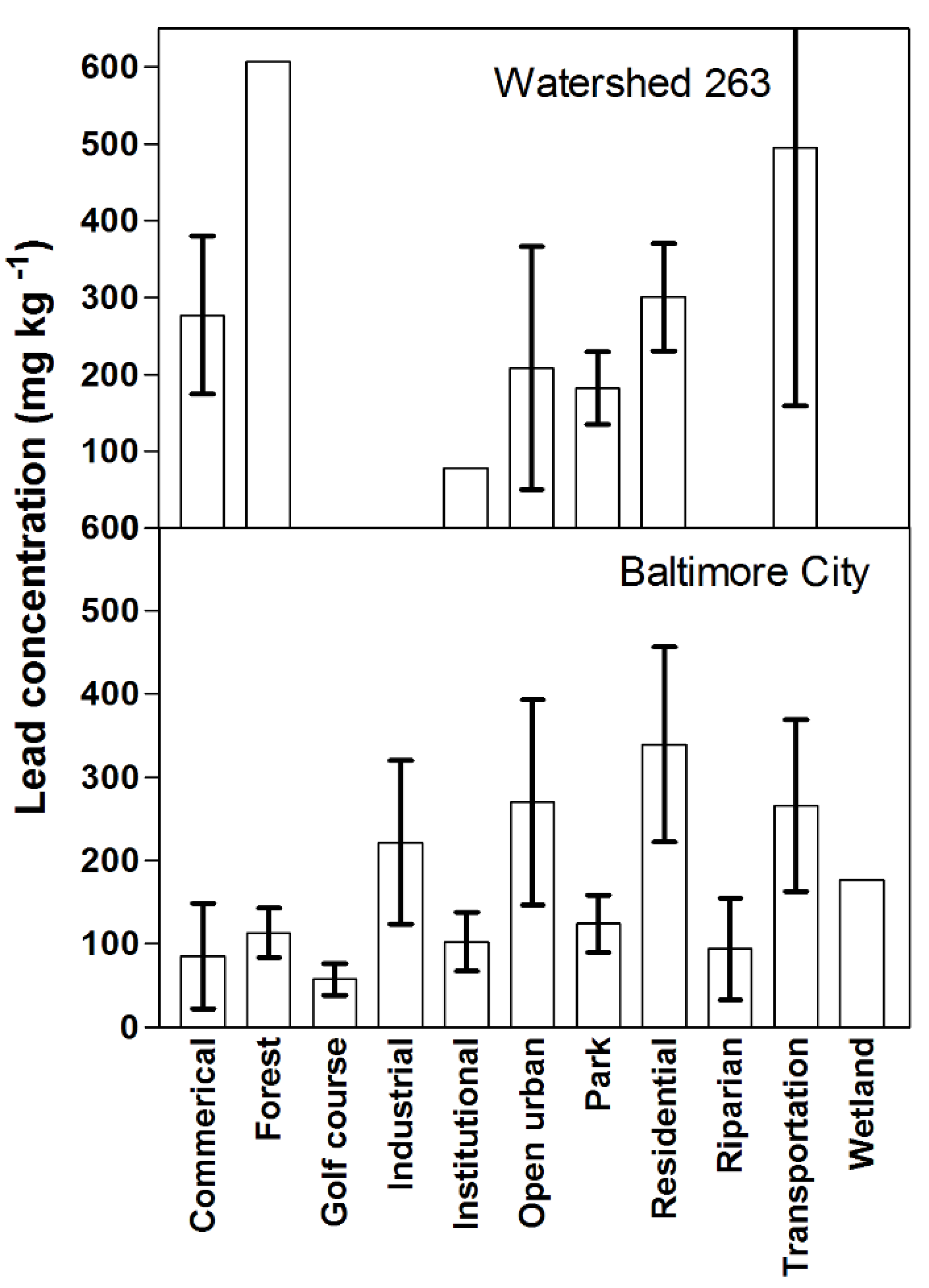
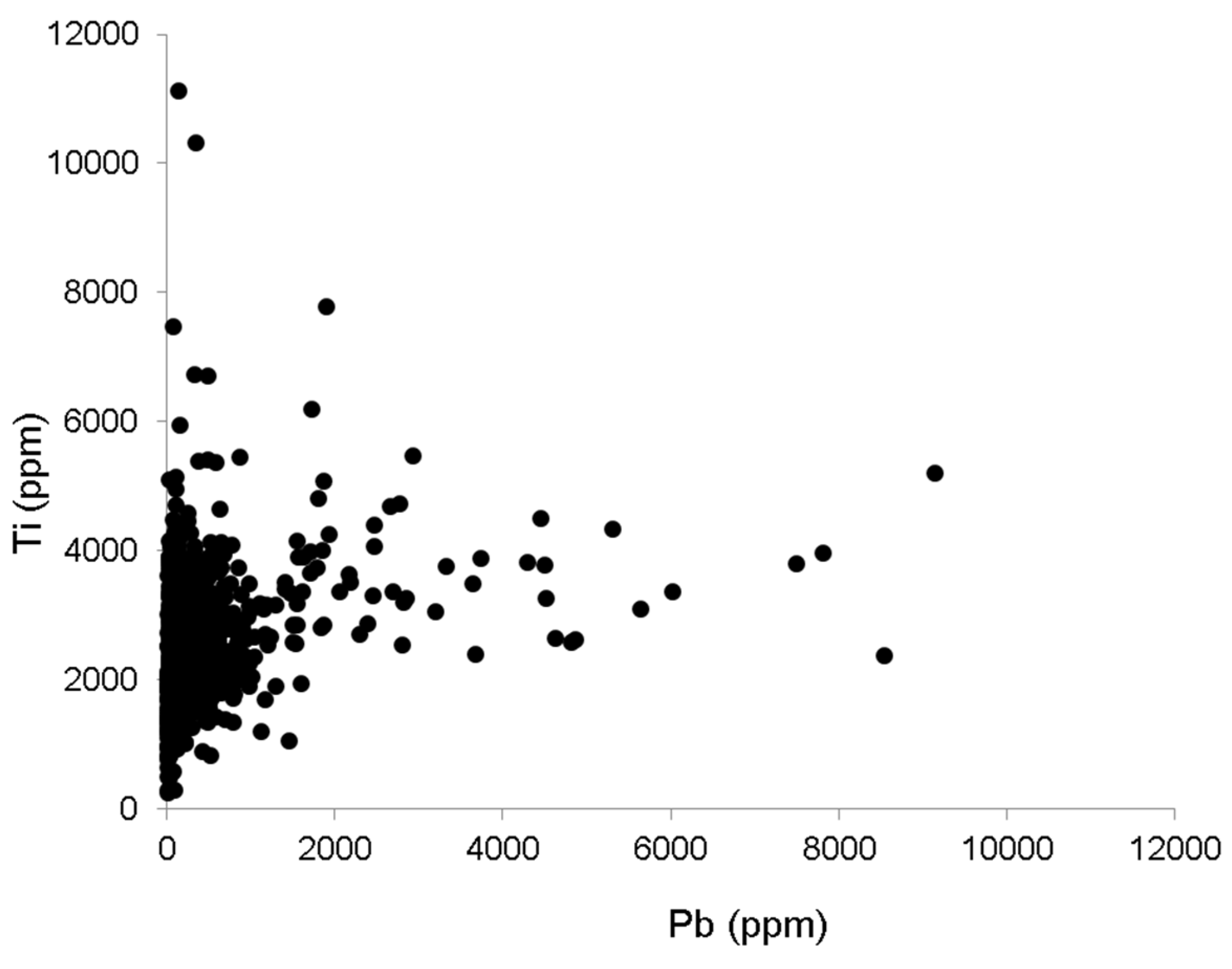
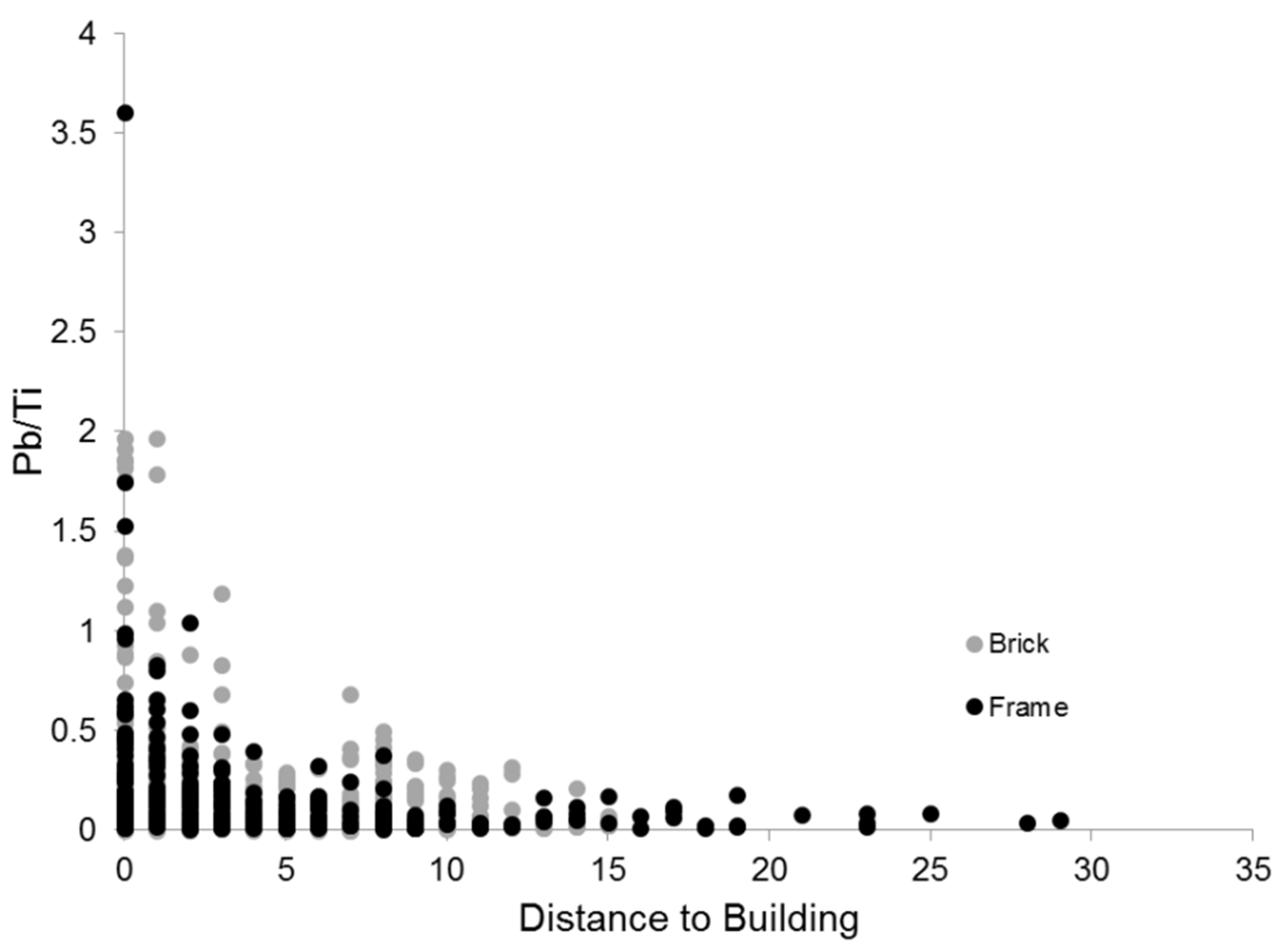
4. A Framework for Management
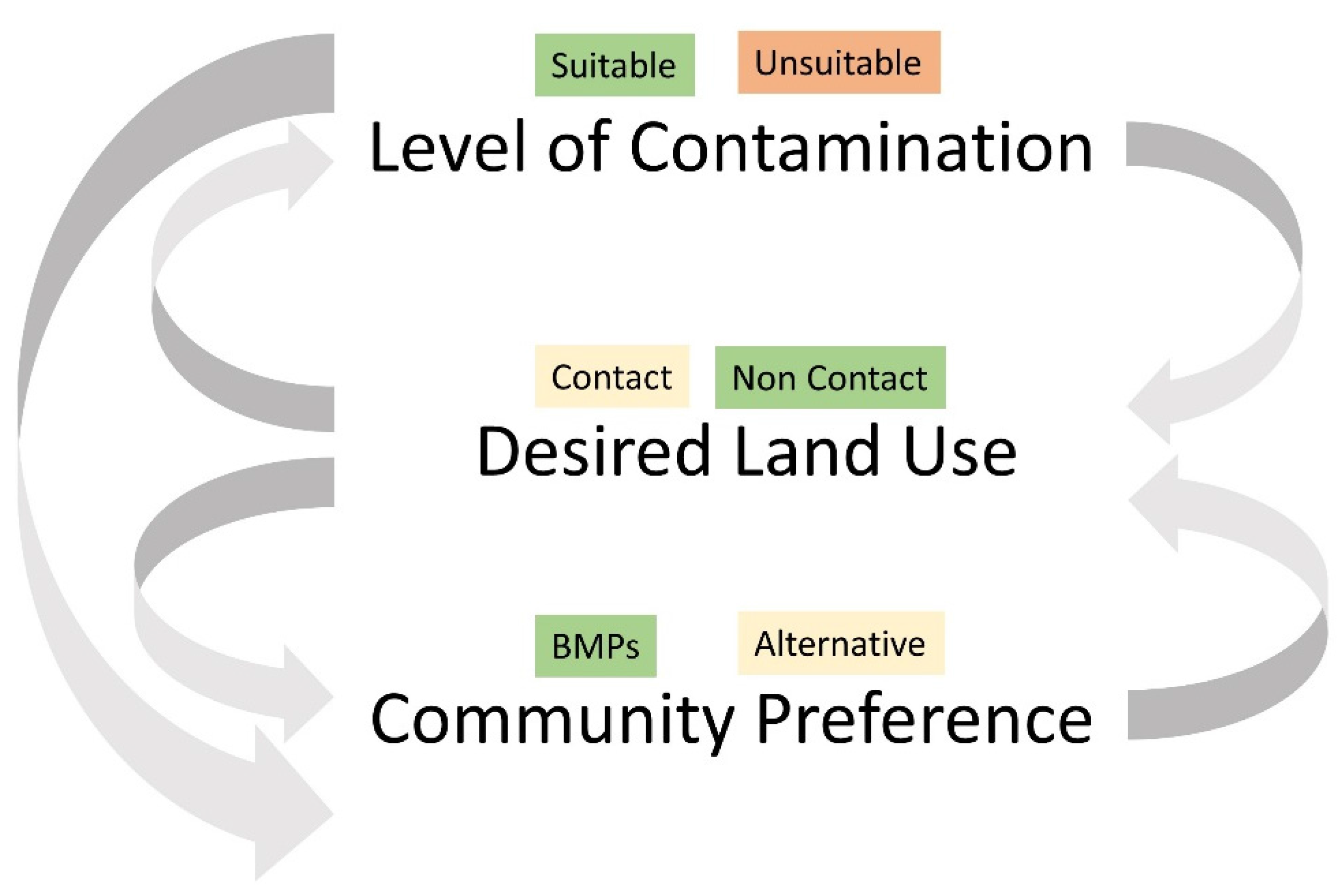
5. Conclusions
Acknowledgments
Author Contributions
Conflicts of Interest
References
- Pouyat, R.V.; Yesilonis, I.; Russell-Anelli, J.; Neerchal, N.K. Soil Chemical and Physical Properties that Differentiate Urban Land-use and Cover Types. Soil Water Manag. Conserv. 2007, 71, 1010–1019. [Google Scholar] [CrossRef]
- Schwarz, K.; Pickett, S.T.; Lathrop, R.G.; Weathers, K.C.; Pouyat, R.V.; Cadenasso, M.L. The Effects of the Urban Built Environment on the Spatial Distribution of Lead in Residential Soils. Environ. Pollut. 2012, 163, 32–39. [Google Scholar] [CrossRef] [PubMed]
- Yesilonis, I.; Pouyat, R.; Neerchal, N. Spatial Distribution of Metals in Soils in Baltimore, Maryland: Role of Native Parent Material, Proximity to Major Roads, Housing Age and Screening Guidelines. Environ. Pollut. 2008, 156, 723–731. [Google Scholar] [CrossRef] [PubMed]
- Holmgren, G.; Meyer, M.; Chaney, R.; Daniels, R. Cadmium, Lead, Zinc, Copper, and Nickel in Agricultural Soils of the United States of America. J. Environ. Qual. 1993, 22, 335–348. [Google Scholar] [CrossRef]
- Mielke, H.W.; Reagan, P.L. Soil is an Important Pathway of Human Lead Exposure. Environ. Health Perspect. 1998, 106 (Suppl. 1), 217–229. [Google Scholar] [CrossRef] [PubMed]
- Rabinowitz, M.B. Lead Isotopes in Soils Near Five Historic American Lead Smelters and Refineries. Sci. Total Environ. 2005, 346, 138–148. [Google Scholar] [CrossRef] [PubMed]
- Collett, R.; Oduyemi, K.; Lill, D. An Investigation of Environmental Levels of Cadmium and Lead in Airborne Matter and Surface Soils within the Locality of a Municipal Waste Incinerator. Sci. Total Environ. 1998, 209, 157–167. [Google Scholar] [CrossRef]
- Liang, F.; Zhang, G.; Tan, M.; Yan, C.; Li, X.; Li, Y.; Li, Y.; Zhang, Y.; Shan, Z. Lead in Children’s Blood is mainly Caused by Coal-Fired Ash After Phasing Out of Leaded Gasoline in Shanghai. Environ. Sci. Technol. 2010, 44, 4760–4765. [Google Scholar] [CrossRef] [PubMed]
- Impact of Lead-Contaminated Soil on Public Health US Department of Health and Human Services, Public Health Service, Centers for Disease Control, Agency for Toxic Substances and Disease Registry. Available online: http://wonder.cdc.gov/wonder/prevguid/p0000015/p0000015.asp (accessed on 18 December 2015).
- Laidlaw, M.A.; Filippelli, G.M. Resuspension of Urban Soils as a Persistent Source of Lead Poisoning in Children: A Review and New Directions. Appl. Geochem. 2008, 23, 2021–2039. [Google Scholar] [CrossRef]
- Lanphear, B.P.; Matte, T.D.; Rogers, J.; Clickner, R.P.; Dietz, B.; Bornschein, R.L.; Succop, P.; Mahaffey, K.R.; Dixon, S.; Galke, W.; et al. The Contribution of Lead-Contaminated House Dust and Residential Soil to Children’s Blood Lead Levels: A Pooled Analysis of 12 Epidemiologic Studies. Environ. Res. 1998, 79, 51–68. [Google Scholar] [CrossRef] [PubMed]
- Mielke, H.; Gonzales, C.; Smith, M.; Mielke, P. The Urban Environment and Children’s Health: Soils as an Integrator of Lead, Zinc, and Cadmium in New Orleans, Louisiana, USA. Environ. Res. 1999, 81, 117–129. [Google Scholar] [CrossRef] [PubMed]
- Canfield, R.L.; Henderson, C.R.; Cory-Slechta, D.A.; Cox, C.; Jusko, T.A.; Lanphear, B.P. Intellectual Impairment in Children with Blood Lead Concentrations Below 10 µg Per Deciliter. N. Engl. J. Med. 2003, 348, 1517–1526. [Google Scholar] [CrossRef] [PubMed]
- Lanphear, B.P.; Hornung, R.; Khoury, J.; Yolton, K.; Baghurst, P.; Bellinger, D.C.; Canfield, R.L.; Dietrich, K.N.; Bornschein, R.; Greene, T.; et al. Low-Level Environmental Lead Exposure and Children’s Intellectual Function: An International Pooled Analysis. Environ. Health Perspect. 2005, 113, 894–899. [Google Scholar] [CrossRef] [PubMed]
- Desmurget, M.; Richard, N.; Harquel, S.; Baraduc, P.; Szathmari, A.; Mottolese, C.; Sirigu, A. Neural Representations of Ethologically Relevant Hand/Mouth Synergies in the Human Precentral Gyrus. Proc. Natl. Acad. Sci. USA 2014, 111, 5718–5722. [Google Scholar] [CrossRef] [PubMed]
- Yeoh, B.; Woolfenden, S.; Lanphear, B.; Ridley, G.F.; Livingstone, N.; Jorgensen, E. Household Interventions for Preventing Domestic Lead Exposure in Children; John Wiley & Sons: Hoboken, NJ, USA, 2014. [Google Scholar]
- Mielke, H.W.; Anderson, J.C.; Berry, K.J.; Mielke, P.W.; Chaney, R.L.; Leech, M. Lead Concentrations in Inner-City Soils as a Factor in the Child Lead Problem. Am. J. Public Health 1983, 73, 1366–1369. [Google Scholar] [CrossRef] [PubMed]
- Mahar, A.; Ping, W.; Ronghua, L.; Zhang, Z. Immobilization of Lead and Cadmium in Contaminated Soil using Amendments: A Review. Pedosphere 2015, 25, 555–568. [Google Scholar] [CrossRef]
- Pincetl, S. From the Sanitary City to the Sustainable City: Challenges to Institutionalising Biogenic (Nature’s Services) Infrastructure. Local Environ. 2010, 15, 43–58. [Google Scholar] [CrossRef]
- Clark, H.F.; Brabander, D.J.; Erdil, R.M. Sources, Sinks, and Exposure Pathways of Lead in Urban Garden Soil. J. Environ. Qual. 2006, 35, 2066–2074. [Google Scholar] [CrossRef] [PubMed]
- Clark, H.F.; Hausladen, D.M.; Brabander, D.J. Urban Gardens: Lead Exposure, Recontamination Mechanisms, and Implications for Remediation Design. Environ. Res. 2008, 107, 312–319. [Google Scholar] [CrossRef] [PubMed]
- Kim, B.F.; Poulsen, M.N.; Margulies, J.D.; Dix, K.L.; Palmer, A.M.; Nachman, K.E. Urban Community Gardeners’ Knowledge and Perceptions of Soil Contaminant Risks. PLoS ONE 2014, 9, e87913. [Google Scholar] [CrossRef] [PubMed]
- Clarke, L.W.; Jenerette, G.D.; Bain, D.J. Urban Legacies and Soil Management Affect the Concentration and Speciation of Trace Metals in Los Angeles Community Garden Soils. Environ. Pollut. 2015, 197, 1–12. [Google Scholar] [CrossRef] [PubMed]
- Nowak, D.J.; Crane, D.E. The Urban Forest Effects (UFORE) Model: Quantifying Urban Forest Structure and Functions. Available online: http://www.nrs.fs.fed.us/pubs/8420 (accessed on 18 December 2015).
- Anderson, J.R.; Hardy, E.E.; Roach, J.T.; Witmer, R.E. A Land Use and Land Cover Classification System for Use with Remote Sensor Data; United States Government Printing Office: Washington, DC, USA, 1976; Volume 964, pp. 1–28.
- EPA1996, U.S. Method 3050B: Acid Digestion of Sediments, Sludges, and Soils; Environmental Protection Agency: Washington, DC, USA, 1996. [Google Scholar]
- Ellis, E.C.; Ramankutty, N. Putting People in the Map: Anthropogenic Biomes of the World. Front. Ecol. Environ. 2008, 6, 439–447. [Google Scholar] [CrossRef]
- Jennings, A.A.; Petersen, E.J. Variability of North American Regulatory Guidance for Heavy Metal Contamination of Residential Soil. J. Environ. Eng. Sci. 2006, 5, 485–508. [Google Scholar] [CrossRef]
- Jennings, A.A. Analysis of Worldwide Regulatory Guidance for Surface Soil Contamination. J. Environ. Eng. Sci. 2008, 7, 597–615. [Google Scholar] [CrossRef]
- Jennings, A.A. Analysis of Worldwide Regulatory Guidance Values for the most Commonly Regulated Elemental Surface Soil Contamination. J. Environ. Manag. 2013, 118, 72–95. [Google Scholar] [CrossRef] [PubMed]
- U.S. Environmental Protection Agency. Technical Review Workgroup Recommendations regarding Gardening and Reducing Exposure to Lead-Contaminated Soils. US Environmental Protection Agency: Washington, DC, USA, 2014. [Google Scholar]
- Schwarz, K.; Weathers, K.C.; Pickett, S.T.; Lathrop, R.G., Jr.; Pouyat, R.V.; Cadenasso, M.L. A Comparison of Three Empirically Based, Spatially Explicit Predictive Models of Residential Soil Pb Concentrations in Baltimore, Maryland, USA: Understanding the Variability within Cities. Environ. Geochem. Health 2013, 35, 495–510. [Google Scholar] [CrossRef] [PubMed]
- Manta, D.S.; Angelone, M.; Bellanca, A.; Neri, R.; Sprovieri, M. Heavy Metals in Urban Soils: A Case Study from the City of Palermo (Sicily), Italy. Sci. Total Environ. 2002, 300, 229–243. [Google Scholar] [CrossRef]
- Zhang, C. Using Multivariate Analyses and GIS to Identify Pollutants and their Spatial Patterns in Urban Soils in Galway, Ireland. Environ. Pollut. 2006, 142, 501–511. [Google Scholar] [CrossRef] [PubMed]
- Werkenthin, M.; Kluge, B.; Wessolek, G. Metals in European Roadside Soils and Soil solution–A Review. Environ. Pollut. 2014, 189, 98–110. [Google Scholar] [CrossRef] [PubMed]
- Pouyat, R.; Szlavecz, K.; Yesilonis, I.; Wong, C.; Murawski, L.; Marra, P.; Casey, R.; Lev, S. Multi-Scale Assessment of Metal Contamination in Residential Soil and Soil Fauna: A Case Study in the Baltimore–Washington Metropolitan Region, USA. Landsc. Urban Plann. 2015, 142, 7–17. [Google Scholar] [CrossRef]
- Schmitt, M.D.; Trippler, D.J.; Wachtler, J.N.; Lund, G.V. Soil Lead Concentrations in Residential Minnesota as Measured by ICP-AES. Water Air Soil Pollut. 1988, 39, 157–168. [Google Scholar] [CrossRef]
- Govil, P.; Reddy, G.; Krishna, A. Contamination of Soil due to Heavy Metals in the Patancheru Industrial Development Area, Andhra Pradesh, India. Environ. Geol. 2001, 41, 461–469. [Google Scholar]
- Kaminski, M.D.; Landsberger, S. Heavy Metals in Urban Soils of East St. Louis, IL, Part I: Total Concentration of Heavy Metals in Soils. J. Air Waste Manag. Assoc. 2000, 50, 1667–1679. [Google Scholar] [CrossRef] [PubMed]
- Walsh, D.C.; Chillrud, S.N.; Simpson, H.J.; Bopp, R.F. Refuse Incinerator Particulate Emissions and Combustion Residues for New York City during the 20th Century. Environ. Sci. Technol. 2001, 35, 2441–2447. [Google Scholar] [CrossRef] [PubMed]
- Russell-Anelli, J.; Bryant, R.; Galbraith, J. Evaluating the Predictive Properties of Soil Survey-soil Characteristics, Land Practices and Concentration of Elements. In Classification, Correlation, and Management of Anthropogenic Soils, Proceedings of the Nevada and California Workshop, 21 September–2 October 1998; Kimble, J.M., Ahrens, R.J., Bryant, R.B., Eds.; USDA Natural Resource Conservation Service National Survey Center: Lincoln, NE, USA, 1998; pp. 155–168. [Google Scholar]
- Pouyat, R.V.; Yesilonis, I.D.; Szlavecz, K.; Csuzdi, C.; Hornung, E.; Korsós, Z.; Russell-Anelli, J.; Giorgio, V. Response of Forest Soil Properties to Urbanization Gradients in Three Metropolitan Areas. Landsc. Ecol. 2008, 23, 1187–1203. [Google Scholar] [CrossRef]
- Inman, J.C.; Parker, G. Decomposition and Heavy Metal Dynamics of Forest Litter in Northwestern Indiana. Environ. Pollut. 1978, 17, 39–51. [Google Scholar] [CrossRef]
- Watmough, S.; Hutchinson, T.; Sager, E. Changes in Tree Ring Chemistry in Sugar Maple (Acer Saccharum) Along an Urban-rural Gradient in Southern Ontario. Environ. Pollut. 1998, 101, 381–390. [Google Scholar] [CrossRef]
- Pavao-Zuckerman, M.A. Soil Ecology along an Urban to Rural Gradient in the Southern Appalachians; The Odum School of Ecology, University of Georgia: Athens, GA, USA, 2003. [Google Scholar]
- Carreiro, M.M.; Pouyat, R.V.; Tripler, C.E.; Zhu, W. Carbon and nitrogen cycling in soils of remnant forests along urban-rural gradients: Case studies in the New York metropolitan area and Louisville, Kentucky. In Ecology of Cities and Towns: A Comparative Approach; Cambridge University Press: New York, NY, USA, 2009; pp. 308–328. [Google Scholar]
- Datko-Williams, L.; Wilkie, A.; Richmond-Bryant, J. Analysis of U.S. Soil Lead (Pb) Studies from 1970 to 2012. Sci. Total Environ. 2014, 468, 854–863. [Google Scholar] [CrossRef] [PubMed]
- Xia, X.; Chen, X.; Liu, R.; Liu, H. Heavy Metals in Urban Soils with various Types of Land use in Beijing, China. J. Hazard. Mater. 2011, 186, 2043–2050. [Google Scholar] [CrossRef] [PubMed]
- Schwarz, K. The Spatial Distribution of Lead in Urban Residential Soil and Correlations with Urban Land Cover in Baltimore, Maryland. Available online: https://rucore.libraries.rutgers.edu/rutgers-lib/26565/ (accessed on 18 December 2015).
- Zahran, S.; Mielke, H.W.; McElmurry, S.P.; Filippelli, G.M.; Laidlaw, M.A.; Taylor, M.P. Determining the Relative Importance of Soil Sample Locations to Predict Risk of Child Lead Exposure. Environ. Int. 2013, 60, 7–14. [Google Scholar] [CrossRef] [PubMed]
- Hettiarachchi, G.M.; Pierzynski, G.M. Soil Lead Bioavailability and in Situ Remediation of Lead-contaminated Soils: A Review. Environ. Prog. 2004, 23, 78–93. [Google Scholar] [CrossRef]
- Rieuwerts, J.; Thornton, I.; Farago, M.; Ashmore, M. Factors Influencing Metal Bioavailability in Soils: Preliminary Investigations for the Development of a Critical Loads Approach for Metals. Chem. Speciat. Bioavailab. 1998, 10, 61–75. [Google Scholar] [CrossRef]
- Cutts, B.B.; Fang, D.; Hornik, K.; London, J.K.; Schwarz, K.; Cadenasso, M.L. Media Frames and Shifting Places of Environmental (In)Justice: A Qualitative Historical GIS Method. Environ. Justice 2016, in press. [Google Scholar]
- Patterson, C.T. An Alternative Perspective-Lead Pollution in the Human Environment: Origin, Extent, and Significance. In Lead in the Human Environment; National Academies: Washington, DC, USA, 1980; pp. 265–349. [Google Scholar]
- Hou, J.; Johnson, J.; Lawson, L.J. Greening Cities, Growing Communities: Learning from Seattle’s Urban Community Gardens; Landscape Architecture Foundation: Washington, DC, USA, 2009. [Google Scholar]
© 2016 by the authors; licensee MDPI, Basel, Switzerland. This article is an open access article distributed under the terms and conditions of the Creative Commons by Attribution (CC-BY) license (http://creativecommons.org/licenses/by/4.0/).
Share and Cite
Schwarz, K.; Pouyat, R.V.; Yesilonis, I. Legacies of Lead in Charm City’s Soil: Lessons from the Baltimore Ecosystem Study. Int. J. Environ. Res. Public Health 2016, 13, 209. https://doi.org/10.3390/ijerph13020209
Schwarz K, Pouyat RV, Yesilonis I. Legacies of Lead in Charm City’s Soil: Lessons from the Baltimore Ecosystem Study. International Journal of Environmental Research and Public Health. 2016; 13(2):209. https://doi.org/10.3390/ijerph13020209
Chicago/Turabian StyleSchwarz, Kirsten, Richard V. Pouyat, and Ian Yesilonis. 2016. "Legacies of Lead in Charm City’s Soil: Lessons from the Baltimore Ecosystem Study" International Journal of Environmental Research and Public Health 13, no. 2: 209. https://doi.org/10.3390/ijerph13020209
APA StyleSchwarz, K., Pouyat, R. V., & Yesilonis, I. (2016). Legacies of Lead in Charm City’s Soil: Lessons from the Baltimore Ecosystem Study. International Journal of Environmental Research and Public Health, 13(2), 209. https://doi.org/10.3390/ijerph13020209




